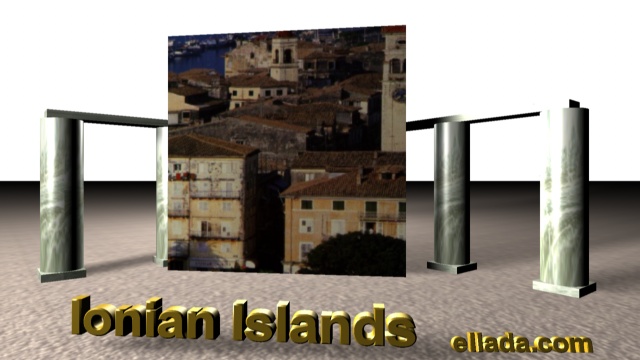
Kerkyra
The Ionian Islands - the Heptanisa (Seven Islands), as they are called in Greek - are situated on the western reaches of the country from the Albanian coast in the north to the southern tip of the Peloponnese and offer a completely different flavour of Greece. A flavour of lush green woods right down to the gentle sea of beckoning coves. They are renown all over the world for their exquisite beauty, a fact which explains the large number of tourists visiting them every year. With their centuries old historical and cultural background, the Ionian Islands have offered a very significant contribution to western cultural civilisation.
From ancient times, the Heptanisa are known as a naval power as well as commercial and cultural centres. During the early years of the classical era (c. 480-323 BC) the islands attained their greatest power. But even in later Macedonian and Roman times the Heptanisa remained independent and were developed as important ports. Later, during the Byzantine times, they belonged to the eastern Administrative Districts of the Empire, even though, ecclesiastically and politically, they developed close ties with the western world. In c. AD 890, Leo IV the Wise formed most or all of the islands into a province of the Byzantine Empire as the theme of Cephalonia. Because of their strategic maritime location between the Greek and Italian mainlands, intervention from outside has always influenced the development of the islands and their people since classical times. During the 11th and the 12th century they were first conquered by Venetians and then by the Normans,who were chiefly responsible for repeated sackings and widespread destruction. In 1081, the Norman Robert Guiscard captured Corfu and Cephalonia, When the Latin Empire (1204-61) was established at Constantinople, the Venetians received Corfu; but in 1214 the Greek despotate of Epirus annexed the first Venetian colony, and a long period of Epirote, Sicilian, and Neapolitan-Angevin rule followed until 1386, when Corfu submitted voluntarily to the Venetian republic. In 1479 the Turks captured the islands of Cephalonia, Zacynthus, Leucas, and Ithaca, annexing them to their empire. The Venetians soon counterattacked and retook them during the 15th and 16th centuries.
The Venetians won the adherence of the principal local families on the islands by the bestowal of titles and appointments. The Roman Catholic church was established there, and the Italians and Greeks intermarried. Greek almost ceased to be spoken except by the peasantry, who remained faithful to the Greek Orthodox communion. On the fall of the Venetian republic in 1797, the islands were awarded to France, whose rule was quickly ended by a Russo-Turkish force (1798-99). Reclaimed by France in 1807 and made an integral part of the French empire under Napoleon, the islands were placed by the Treaty of Paris (1815) under the exclusive protection of Great Britain.
An Ionian senate and legislative assembly began to function in 1818, but real authority was vested in a British high commissioner. Schools of higher learning and a judiciary were set up, but the inhabitants resented the restrictions imposed by the firm British rule. After 1848 periodic insurrections by the peasantry, notably in Cephalonia, had to be put down with force, and the Ionian parliament voted for immediate union with the new Greek kingdom. In 1864 Britain ceded the islands to Greece as a gesture marking the accession of a new Greek king, George I (the former Prince William George of Gl�cksburg), son of Christian IX of Denmark. Following their annexation, the prosperity of the islands decreased, partly because of the loss of the special tax and trading privileges granted under the protectorate. The islands were occupied by Italy and, later, Germany during World War II. They were liberated with the rest of Greece in 1944.
The long period of occupation by so many foreign powers has left an indelible mark on the islands, a fact which, combined with their natural beauty, gives them a unique attractiveness and a strong non-Greek flavour. For example, the enormous central square of the town of Kerkyra incorporates the only known British cricket pitch in Greece (and probably in the whole of the Mediterranean), and the local team has a lot of trophies to be proud of!
The Heptanisa comprise Corfu (K�rkyra), Cephalonia (Kefallin�a), Zacynthus (Z�kinthos, Zante), Leucas (Levk�s), Ithaca (Ith�ki), Cythera (K�thira), and Paxos (Paxo�) and numerous other small islands such as the rarely visited Erikoussa, Othonoi and Mathrakio, at the northern most reaches of the Heptanisa. They have a combined land area of about 900 square miles (about 2,350 square km). The total population (1991 census) is about 191,000.
For the purposes of this guide, the Ionian islands are divided in the following areas. A map of the area, highlighting these islands, is available here.
Kerkyra - Corfu
Kefalonia - Cephalonia
Zakinthos
Paxos
Ithaca
Lefkada - Lefkas
Kithira and other islands
|